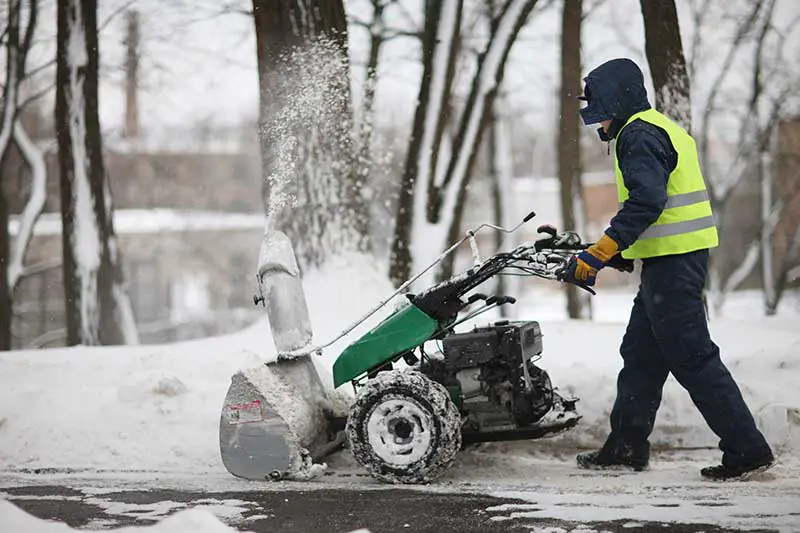Snowblowers can backfire due to carburetor issues, low-quality or stale fuel, incorrect engine timing, a faulty spark plug, a blocked exhaust system, loose or damaged exhaust components, or ignition system problems. Identifying and addressing the cause can help ensure your snowblower’s safe and efficient operation.

A backfiring snowblower can be both startling and concerning. Backfiring occurs when unburned fuel ignites in the exhaust system rather than in the combustion chamber. This can cause a loud noise and, in some cases, damage to your snowblower. Understanding the possible causes and solutions can help you address this issue effectively. Here are some common reasons why your snowblower might be backfiring and how to fix them.
Carburetor Issues
An improperly adjusted or dirty carburetor can cause a lean fuel mixture, leading to incomplete combustion and backfiring. To fix this:
- Clean the carburetor to remove any debris or buildup.
- Inspect the carburetor for any signs of wear or damage.
- Adjust the carburetor settings according to the manufacturer’s specifications.
- If you’re not comfortable doing this yourself, consider taking your snowblower to a professional.
Low-Quality or Stale Fuel
Low-quality or stale fuel can cause incomplete combustion, resulting in a backfire. To resolve this issue:
- Drain the old fuel from your snowblower.
- Fill the tank with fresh, high-quality gasoline.
- Use a fuel stabilizer to prevent fuel degradation during periods of non-use.
Incorrect Engine Timing
If the engine’s timing is off, it can lead to incomplete combustion and backfiring. To address this problem:
- Consult your snowblower’s owner’s manual for instructions on checking and adjusting engine timing.
- If you’re not comfortable with this task, consider taking your snowblower to a professional for inspection and repair.
- Regular maintenance can help prevent timing issues and keep your snowblower running smoothly.
Faulty Spark Plug
A faulty spark plug can cause misfires and backfiring. To fix this issue:
- Inspect the spark plug for wear or damage.
- Clean any carbon deposits from the spark plug using a wire brush or a spark plug cleaner.
- Check the spark plug gap and adjust it to the manufacturer’s specifications.
- Replace the spark plug if necessary.
- Make sure to replace the spark plug with the correct type specified by the manufacturer.
Blocked Exhaust System
A blocked or partially blocked exhaust system can cause backpressure, leading to backfiring. To address this issue:
- Inspect the exhaust system for blockages, such as debris or ice.
- Clean the exhaust system if needed.
- Ensure that the exhaust system is free from any obstructions that could hinder the flow of exhaust gases.
- Make sure the exhaust system is properly connected and has no leaks.
Loose or Damaged Exhaust Components
Loose or damaged exhaust components can cause exhaust leaks, which can lead to backfiring. To fix this problem:
- Inspect the exhaust system for loose or damaged components.
- Tighten or replace components as necessary.
- If you suspect that there is a leak in the exhaust system, have it checked by a professional to prevent further issues.
Ignition System Issues
Problems with the ignition system can also cause backfiring. To resolve this issue:
- Inspect the ignition coil for signs of wear or damage.
- Check the ignition wires and connections for any signs of corrosion or damage.
- Replace any faulty ignition components as necessary.
By identifying and addressing the cause of your snowblower’s backfiring, you can help ensure its safe and efficient operation during the winter months. Regular maintenance, such as changing the oil, cleaning the carburetor, and inspecting the spark plug, can prevent backfiring and keep your snowblower running smoothly.
| Cause | Fix |
|---|---|
| Carburetor Issues | Clean and adjust the carburetor; inspect for wear or damage |
| Low-Quality or Stale Fuel | Drain old fuel; use fresh, high-quality gasoline and a fuel stabilizer |
| Incorrect Engine Timing | Check and adjust engine timing; consult owner’s manual or a professional |
| Faulty Spark Plug | Inspect, clean, adjust gap, or replace spark plug as necessary |
| Blocked Exhaust System | Inspect and clean exhaust system; ensure proper flow of exhaust gases |
| Loose or Damaged Exhaust Components | Inspect, tighten, or replace exhaust components as necessary |
| Ignition System Issues | Inspect ignition coil, wires, and connections; replace faulty components |
Importance of Regular Maintenance
Regular maintenance is crucial to prevent backfiring and ensure the proper functioning of your snowblower. By adhering to a maintenance schedule, you can extend the life of your snowblower and minimize the likelihood of backfiring. Some essential maintenance tasks include:
- Changing the oil at least once per season or according to the manufacturer’s recommendations
- Replacing the spark plug as needed
- Cleaning and adjusting the carburetor
- Inspecting and tightening belts, fasteners, and other components
- Lubricating moving parts
Consult your snowblower’s owner’s manual for specific maintenance guidelines and schedules.
Safety Precautions When Dealing with a Backfiring Snowblower
If your snowblower is backfiring, it is essential to take safety precautions to protect yourself and your property. Some steps to ensure safety include:
- Turn off the snowblower and allow it to cool down before inspecting or working on it
- Wear protective gear, such as gloves and safety glasses, when handling or repairing your snowblower
- Keep flammable materials away from the snowblower
- Do not attempt repairs beyond your skill level; seek professional assistance if needed
- Follow the manufacturer’s instructions for troubleshooting and repair
